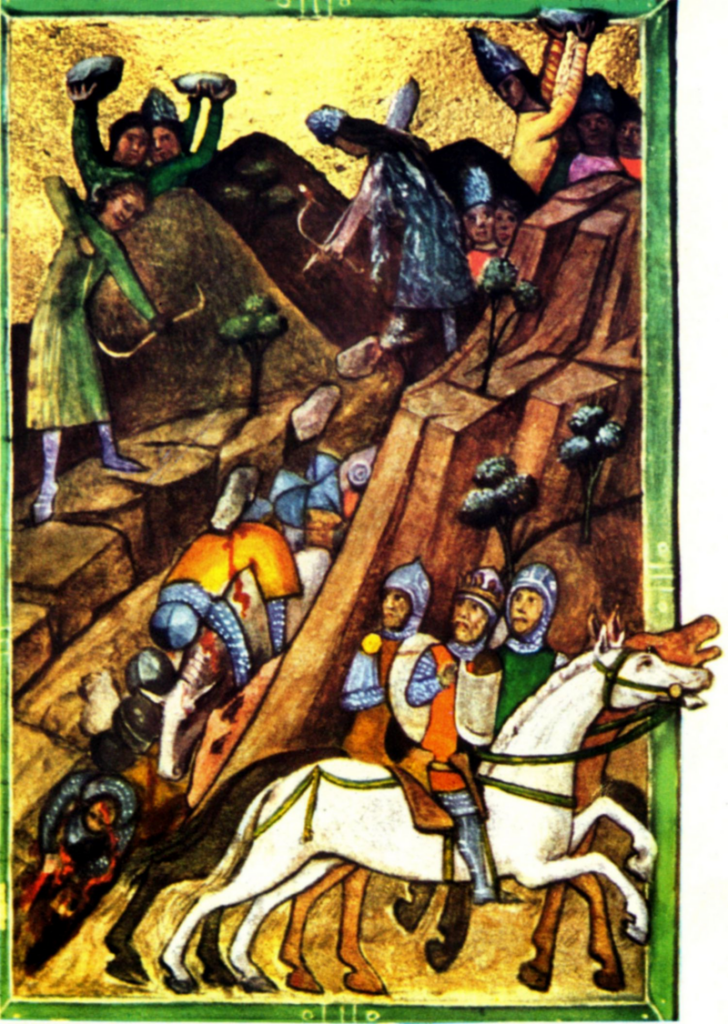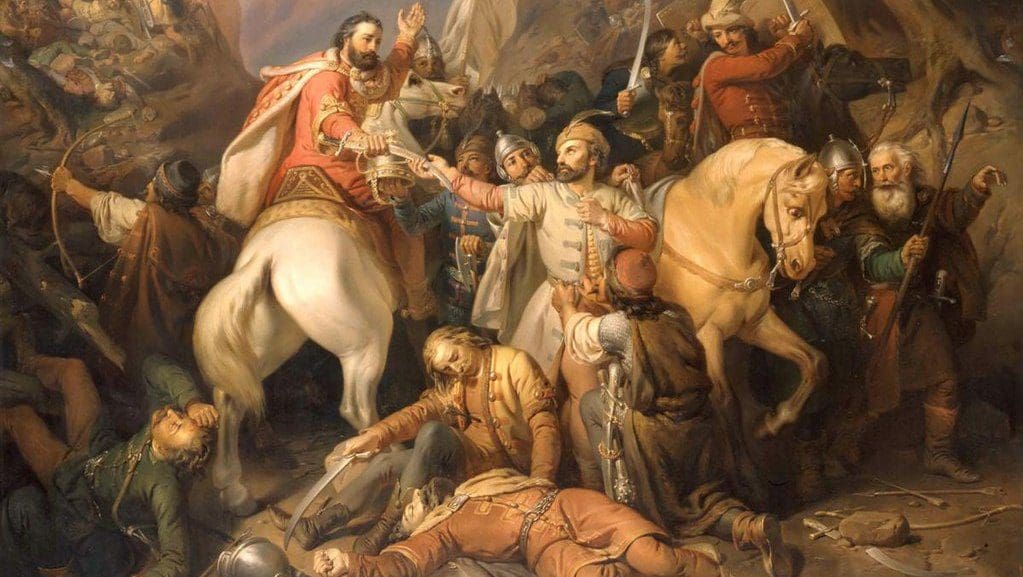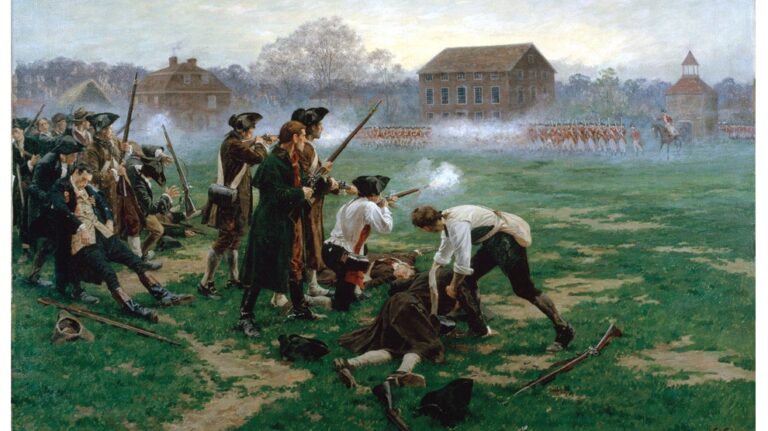Since 1990, the Order of Saint George has been operating again in Hungary; similarly to other re-established orders, it engages in humanitarian activities, and also strives to preserve traditions and strengthen Hungarian national consciousness. Every year in July, the members of the Order also open their doors to the public in Visegrád, in the framework of a public festival next to their medieval royal palace. But what exactly is the origin of the Order of St George?
The Árpád dynasty became extinct in 1301, and although King Charles of Anjou (Charles I, also known as Charles Robert, r. 1308–1342) arrived in Hungary from Naples in the same year, he and his followers fought for many years to obtain the throne, and only managed to secure it in a victorious battle in 1312, as well as after the death of Charles I’s greatest opponent, the oligarch Matthew III Csák of Trencsén, in 1321.[1] The reign of the Angevin kings is traditionally regarded as the first outstanding period of Hungarian chivalric culture, even if the surviving relics and sources fall far short of what might be expected. Surprisingly, the earliest royal secular knightly order in Europe was founded in 1326 in Hungary, a country just emerging from civil war, by King Charles I, in honour of St George, the patron saint of knights since the crusades.[2]
Fortunately, the Order has preserved its original charter, issued in 1326, with its original seal.[3] However, more recent foreign-language works do not consider the surviving charter to be the earliest charter of the Order: the foundation of the Order must have already taken place by that time, since the charter we know today is composed of earlier sources. This is also supported by the fact that two paragraphs at the end of the first part of the document are repeated almost word for word and that King Charles himself was not present at Visegrád, the royal seat where the charter was issued, on 24 April 1326, and he would hardly have done so if the Order had been founded then.
It is probable that the Order was organised around the Chapel of St George in the royal seat of Visegrád, but surprisingly, there are no written sources on its actual functioning—perhaps because it did not function for long.
It is not impossible that
the near-fatal assassination attempt on the royal couple in Visegrád in 1330 put an end to the King’s efforts to found the Order
(especially if the assassin himself had been a member of it), although the main motive for its foundation would have been the same as that of the Ordre du Croissant, which was founded in Naples a few decades later, namely to accelerate the attachment of the local nobility to the dynasty. It was probably founded for the nobles of the Court, who would later be known as the Knights of the Court. This would explain the unprecedented way in which the regulations set out the opportunities and obligations for members of the Order to meet and socialise, with 55 different days set aside each year.

The King tried to keep his supporters close; for example, he donated to Comes Doncs, one of his favourites, the estate of Komárom, so that he could be closer to the Court. A group of barons also built houses and palaces at the royal seat, Visegrád, and later Buda—after 1342, all but two of the palatines had houses in Buda. The most splendid was probably that of influential officeholder, palatine Nicholas I Garai, which he bought in 1385 under the reign of the second Hungarian Anjou king, Louis the Great. An unparalleled description of it survived, giving an insight into the otherwise hidden wealth of the palaces of the period.
Another surprising fact is that we do not know who the members of the medieval Order were; we can only guess their identity. Traditionally, members of the Order were appointed from among barons and dignitaries, but it is by no means certain that they all came only from those ranks. The importance of court knights and pages has become evident in Hungarian historiography in recent decades, and there is good reason to believe that the larger part of the possible members were drawn from among them. This is likely the case even though the number of knights of the Court known by name between 1308 and 1342 is only around seven.
Nevertheless, the barons never called themselves ‘miles’ (knights), or if they did, it was only when they were still knights of the Court. Of course, the order may still have been functioning even if the members did not include the title of knight next to their names in charters. Even in the case of successful orders, such as King Sigismund of Hungary’s Order of the Dragon, it is not by the fact that they called themselves miles that we know the members. As a matter of fact, the order of the German Emperor Frederick III was even characterised by its members not revealing their affiliation, thus forming a ‘hidden order’.
The order may have had an influence on the Order of St Catherine of Dauphiné, governed by Charles’ nephew Humbert II de Viennois. Humbert, whose mother was Charles’ sister, Beatrice, also visited Charles’ court in Hungary. The Order of St Catherine, which he founded in the years before the Smyrniote Crusade in 1346, may well have been modelled on the Hungarian order, which would thus prove its actual functioning, at least according to Boulton’s conjecture.[4]
Even more interestingly, the charter of the Order of St George founded by Charles I states the following among the duties of its members: ‘to follow the king in an outstanding way in every recreational activity and knightly game’.[5] At the time, the authors of the charter in the 1320s had no idea how soon the secular aristocracy would have the opportunity to prove their loyalty to the King on the battlefield as well: in the autumn of 1330, they set out on a not particularly exciting campaign in Wallachia.[6] However, what started out as a brilliant military campaign, almost a chivalrous game,
ended in one of the most disastrous setbacks in medieval Hungarian military history in the mountains of southern Transylvania,
most probably in the Vöröstorony straight (Pasul Turnu Roșu, Romania). The Hungarian army was almost completely annihilated and the King barely escaped, too. There is reason to believe that the participants in the campaign in Wallachia, led by the King himself, may have included actual or would-be members of the order. The knightly army, that is, the courtly retinue, valiantly protected the King as bodyguards, saving his life and preventing his humiliating captivity. Their heroism was commemorated in the Illuminated Chronicle of 1351, in two miniature, but, again surprisingly, the text makes no mention of the order at all.

The heroic deed of Dezső Hédervári, a high-ranking nobleman in the Court of King Charles, recorded in connection with the aforementioned battle in 1330 deserves special attention; the 19th-century depiction of his feat was also included in the illustrated edition of the Hungarian Constitution published a few years ago. The Chronicle gives a prominent role to Hédervári who, swapping armours with the King, sacrificed himself to save Charles’ life. At first glance, the story may seem unbelievable, so the question may rightly arise as to whether the exchange of the armour was cowardice or valorous bravery—but similar examples occurred on numerous occasions in contemporary fiction and on the battlefield, too. Thus, the incident proves that in the mind-set of the time, self-sacrificing heroism was by no means an incredible act.
Of course, there could also have been chivalric literature associated with the order, which would have recorded such achievements. This was the case with the Order of Croissant and the Order of the Knot, but it would indeed be too much to expect of a country just emerging from a civil war. It is another matter that the work of Niccolò Acciaioli (or Acciaiuoli), who recorded the exploits of the Order of the Knot (founded in 1352 by King Louis of Naples), ended up in the hands of Boccaccio, who, after reading the many hair-raising stories, burst into a roar of laughter.
Most of the secular orders founded between the 14th and 16th centuries were extremely short-lived. The reasons for this may have varied, but the common cause may be the political nature of the foundations. As the political situation changed, neither the founder nor the members (or their heirs) made any effort to maintain community life within the orders. In view of the above,
there seems to be nothing extraordinary in the fact that we have no documentary evidence of the functioning of the Order of St George.
It is at least rather close to typical European practice, and it would even be out of the ordinary if the functioning of an order could be traced back over a long period of time. The members themselves, who may have had doubts about new ties and political dependencies that were intended to secure their loyalty, may have entered orders founded by monarchs with varying degrees of enthusiasm. Hence the recurrent obligation in the statutes to wear the order’s insignia and vestments, which they only wore reluctantly.
The founding of the Order of St George can be considered one of the innovations brought to Hungary by the Angevins of Naples, even if we do not really know today how long the undoubtedly palpable royal will and the support of ecclesiastical dignitaries kept the order alive.[7] The charter, the seal of the order, and other small traces such as the existence of the chapel of St George or the shield-supporting dragons on the royal seals all testify to the seriousness of the royal intention. The well-reasoned idea of establishing the order reveals the King and his advisers’ excellent tactical–political sense, just as their undoubted sense of realpolitik may have led them to bring it down not long after its foundation. At that time, the situation in Hungary was not yet ripe for the functioning of the knightly order; that only happened a few decades later, under the reign of King Sigismund.
[1] Jeffrey Anderson, The Angevin Dynasties of Europe, 900–1500: Lords of the Greater Part of the World, Ramsbury, 2019.; Pál Engel, The Realm of St Stephen — A History of Medieval Hungary 895-1526, London, 2001, pp. 130–155.; Enikő Csukovits, ‘Charles Ier ou Charles-Robert, roi de Hongrie’, in de Cevins, Marie-Madeleine, Enikő Csukovits, et al. (eds.), Démystifier l’Europe centrale: Bohême, Hongrie et Pologne du VIIe au XVIe siècle, Paris, 2021, pp. 346–347.
[2] László Veszprémy, ‘L’ordine di San Giorgio’, in Enikő Csukovits (ed.), L’Ungheria angioina, Roma, 2013, pp. 265–282.
[3] D’Arcy Jonathan Boulton, The Knights of the Crown: The Monarchical Orders of Knighthood in Later Medieval Europe 1325–1520. London, 2000, pp. 27-45.
[4] Boulton, The Knights of the Crown, p. 45.
[5] Boulton, The Knights of the Crown, p. 36.
[6] Radu Lupescu, ‘Walachia, Battle’, in C. J. Rogers (ed.), The Oxford Encyclopaedia of Medieval Warfare and Military Technology, Oxford, 2010, Vol. 3, pp. 423–424.
[7] Enikő Csukovits, ‘Le innovazioni istituzionali nell’età angioina e i loro parallelismi napoletani’, in Enikő Csukovits (ed.), L’Ungheria angioina, pp. 59–119.
Related articles:








